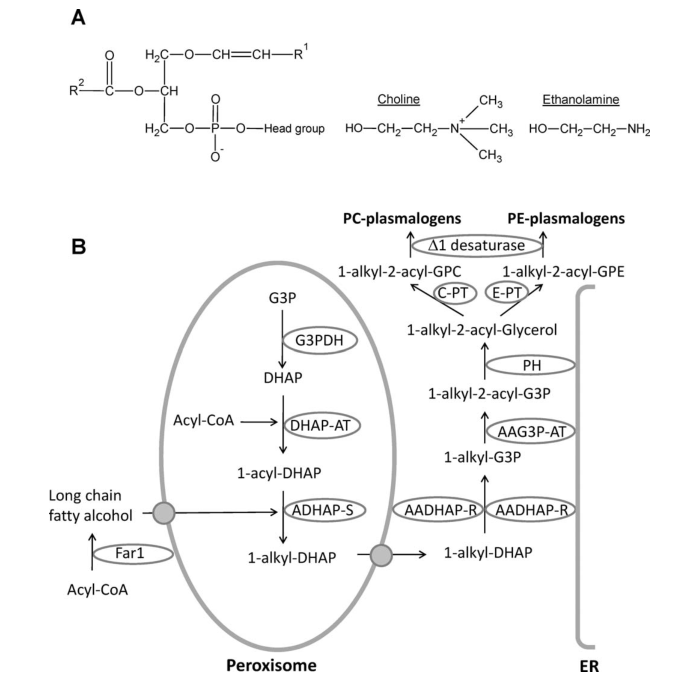Plasmalogens represent a class of phospholipids characterized by a vinyl ether bond in sn-1 and an ester bond in sn-2 position of the glycerol backbone. They are expressed in numerous mammalian tissues at varying amounts and exhibit a distinct species distribution. The predominant classes of plasmalogens are glycerophosphoryl-ethanolamine (PE) and glycerophosphoryl-choline (PC), depending on the head group.
The basic chemical structure common to all plasmalogens is depicted in the above figure. The long chain fatty alcohol (R1) in sn-1 consists almost exclusively of 16:0, 18:0, and 18:1 alkenyl groups, while sn-2 (R2) is esterified predominantly with ω-6 or ω-3 derived polyunsaturated fatty acids. While the sn-2 acyl chain is at all segments oriented perpendicularly to the membrane surface, the head group lacks a carbonyl oxygen in sn-1 position and therefore exhibits a stronger lipophilicity. This change in headgroup structure in turn leads to stronger intermolecular hydrogen bonding between head groups and is able to directly disturb cellular membranes. Although plasmalogens constitute 18% of the total phospholipid mass in humans, for quite some time they have been considered an oddity with no clearly ascribable physiological function aside from being a membrane structure component.
 Figure 1 Overview over plasmalogen structure and biosynthesis.
Figure 1 Overview over plasmalogen structure and biosynthesis.
Till now an increasing number of cellular functions have been uncovered, including neurochemical effects, intra- and extra-cellular signaling, and the ability to act as radical scavengers. There have also been reports on their involvement in the proper assembly and function of multispan transmembrane transport proteins and ion-channels and on the diffusion of NO and other signal-transduction molecules. Pathophysiologically they seem not only to be involved in neurodegeneration, which was the first disease-association discovered, but also play a role in common diseases such as cardiac failure, type 2 diabetes, obesity, inflammation, and cancer. Further possibilities to address plasmalogen biology in vivo were finally opened up in 2006 when an ether-lipid deficient mouse model was generated.
Now, scientists at Creative Proteomics have developed a reliable and reproducible method using highly sensitive LC-MS/MS platform for the rapid identification and quantification of diverse plasmalogens in different sample types. We’re willing to provide Plasmalogens Analysis Service to satisfy the needs of academic and industrial study in your lab.
Platform
- LC-MS/MS
Summary
- Identification and quantification of plasmalogens
Sample Requirement
- Normal Volume: 100ul plasma; 50mg tissue; 2e7 cells
- Minimal Volume: 50uL plasma; 30mg tissue; 5e6 cells
Report
- A full report including all raw data, MS/MS instrument parameters and step-by-step calculations will be provided (Excel and PDF formats).
- Analytes are reported as uM or ug/mg (tissue), and CV's are generally<10%.
| Plasmalogens | ||
|---|---|---|
| glycerophosphoryl-ethanolamine | glycerophosphoryl-choline | Other plasmalogens |
How to place an order:

*If your organization requires signing of a confidentiality agreement, please contact us by email.
Staffed by experienced biological scientists, Creative Proteomics can provide a wide range of services ranging from the sample preparation to the lipid extraction, characterization, identification and quantification. We are willing to provide our customer the outstanding plasmalogens analysis service with accurate and reliable results, quick turnaround, saving you time and resources! Please feel free to contact us to discuss the wide range of services we can perform.